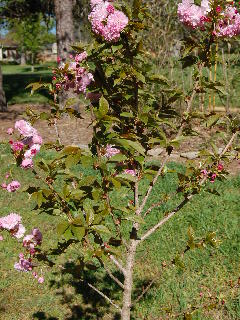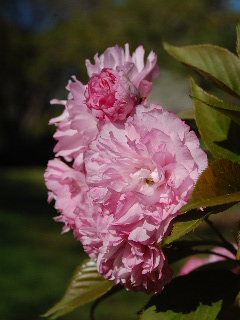
Here’s a great addition to your home landscape--the Kwanzan Flowering Cherry tree.
This showy flowering ornamental tree works well as a stand-alone specimen occupying its own space in your landscape or as part of a border along property lines, driveways, or sidewalks.
This tree (Prunus serrulata Kwanzan) is one of the hardiest of all the cherries and does well in zones 5 through 9, which includes most of the continental United States.
And the Kwanzan is certainly the showiest of the ornamental cherries, with its large clusters of 3 to 5 flowers, each being about 2 1/2 to 3 inches across.
The double pink blossoms somewhat resemble the shape and texture of carnations.
This tree is one of the varieties of cherry planted in Washington, DC, where the magnificent Cherry Blossom Festival is held each spring.
The trees are ideal for the homeowner not only because of their flowering beauty but also because their size (usually less than 30 feet high by 25 feet wide) makes them comfortable for fitting into most landscapes.
The trees are moderate to slow growing and are not particularly long-lived--generally not more than about 35 to 40 years of age.

But, while you have them, they will put on a magnificent visual show for you--from the beautiful full pink spring blossoms through the dark green foliage of summer and into the bronze-yellow-orange of attractive autumn leaves.
The Kwanzan cherry trees need to be planted in an area of full sun in order to produce an abundance of those beautiful pink blossoms--although they will survive in areas of partial shade while just not giving you as many blooms.
Undemanding of soil types, the Kwanzan cherry trees should do well in soils of moderate fertility with good drainage--not overly tight clay and wet soils.
Another positive feature of this tree for the homeowner is that, although it is a cherry tree, the Kwanzan does not produce fruit. This allows for the fact that there will not be messy squashed fruits underneath your tree or possible “by products” from the songbirds which may eat and process such goods onto your lawn, landscape, sidewalk, driveway, or patio.
Also, the Kwanza has a desirable natural “vase” shape with upwardly ascending branches that are generally appropriately spaced so that the tree does not become too tangled or dense internally.
Therefore, the need for extensive pruning is essentially eliminated.